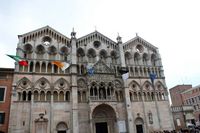Journey to Ferrara
Lagoon city at the Po River
The history of Ferrara and its hinterland has been primarily dominated by the Po River and its tributaries. Ferrara is one of very few cities in Italy without any Roman ancestry. Instead, residents of the lagoons settled here in the 7th century. Throughout subsequent centuries Ferrara had to resist several different intruders before the city fell into the hands of the Este. The dynasty’s influence helped both the city and the region to flourish.
Art metropolis and World Heritage Site
The Este regency lasted more than 300 years and left significant marks throughout the entire region. Ferrara became a hub for art and culture reaching a total of 130,000 inhabitants in the 15th century. This number only was achieved again in 1988 after centuries of decline and stagnation during the church’s regency. Ferrara’s car-free historic city centre has been declared World Heritage Site by the UNESCO regularly attracting tourists from all over Italy and the entire world.
The allure of Ferrara and its hinterland
Ferrara and its hinterland couldn’t be any more diverse. Numerous castles, churches and galleries evoke the influence of the Este, who have shaped the region for centuries. The location at the Po River and its mouths caused nature to blossom. Thick, speciose forests, preserve areas, lakes, rivers, swamps, and beach baths are integral parts of the region. Among the highlights of the hinterland are the channels of Comacchio. The Venice of the Emilia Romagna invites its visitors to explore the historic town centre on boats.
Ferrara and its sweeping hinterland are filled with astonishing highlights. Art and nature, architecture and water form a unique symbiosis presenting its guests with a vast fascinating variety of expeditions.



Tweet